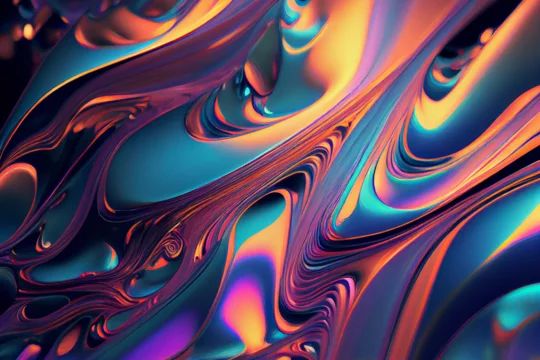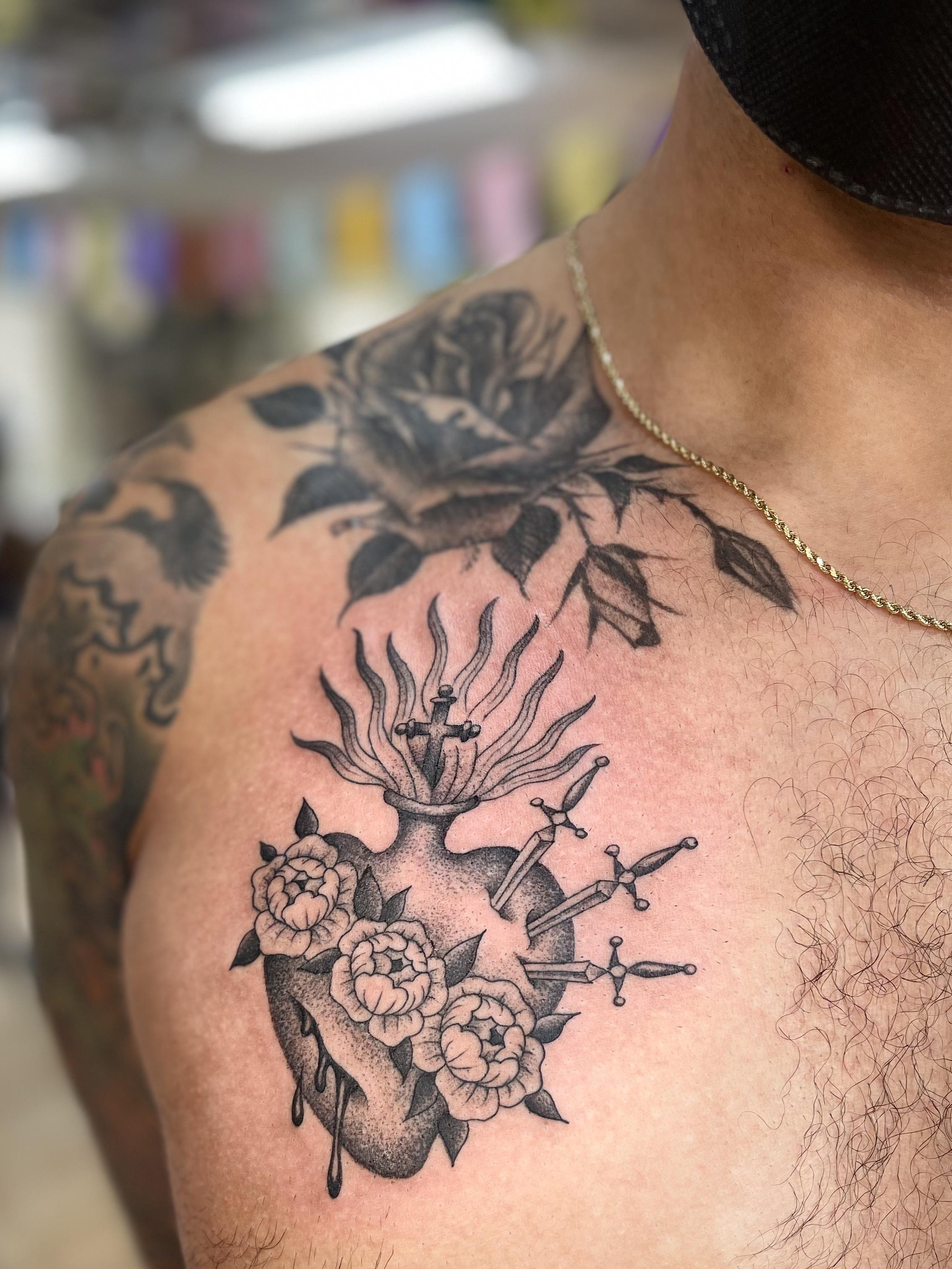The Sacred Heart tattoo is a deeply symbolic and meaningful design, often chosen by individuals seeking to express their religious devotion, spiritual connection, or personal beliefs. This article explores the various aspects of Sacred Heart tattoo designs, delving into their historical context, cultural significance, and the diverse interpretations that make them a popular choice in the world of body art.
The Sacred Heart Symbolism

The Sacred Heart, a depiction of Jesus’ heart, is a powerful symbol in Christianity, representing divine love, compassion, and mercy. This iconic image, often adorned with a crown of thorns and flames, has been a significant element of Christian art and iconography for centuries. The Sacred Heart tattoo draws inspiration from this rich symbolism, allowing individuals to wear their faith and devotion proudly on their skin.
Historical Roots
The origins of the Sacred Heart as a symbol can be traced back to the 17th century, with the visions experienced by Saint Margaret Mary Alacoque, a French nun. These visions, recognized by the Catholic Church, led to the establishment of the Sacred Heart devotion. The image of the Sacred Heart, as we know it today, became a central element of this devotion, and its popularity spread rapidly, especially during the Baroque era.
Cultural Significance
The Sacred Heart has transcended its religious origins to become a symbol of cultural identity, especially within the Latino and Hispanic communities. It represents a deep connection to one’s faith, heritage, and family traditions. Many individuals choose to ink this symbol as a way to honor their cultural roots and pay homage to their ancestors.
Sacred Heart Tattoo Designs: A Spectrum of Interpretations

Sacred Heart tattoos offer a wide range of artistic interpretations, allowing individuals to personalize their tattoos while maintaining the core symbolism. Here are some common design elements and their potential meanings:
Traditional Sacred Heart
A classic Sacred Heart tattoo often features a realistic portrayal of the heart, with intricate details like the crown of thorns, flames, and sometimes even rays of light emanating from the heart. This design is a direct representation of the Christian symbol and carries the traditional meanings of love, sacrifice, and spiritual protection.
| Design Element | Symbolism |
|---|---|
| Crown of Thorns | Remembrance of Christ's suffering and a symbol of strength and resilience. |
| Flames | Divine love and passion, often associated with the Holy Spirit. |
| Rays of Light | Enlightenment, spiritual guidance, and the presence of God. |

Abstract Interpretations
Some artists and individuals opt for a more abstract approach, using the Sacred Heart as a starting point for creative exploration. These tattoos may feature stylized hearts, geometric shapes, or even abstract representations of the heart’s energy. While maintaining the core symbolism, these designs offer a modern twist, appealing to those seeking a unique, contemporary expression of their faith.
Personalized Additions
Many Sacred Heart tattoos are further personalized with additional elements. These can include names, dates, or significant quotes, often in the form of a memorial tattoo. Some individuals choose to add symbols or imagery that hold personal meaning, such as angels, doves, or crosses, creating a truly one-of-a-kind tattoo that tells their unique story.
Cultural Fusion
Given the cultural significance of the Sacred Heart, especially within Latino and Hispanic communities, many artists incorporate cultural elements into their Sacred Heart tattoos. This might include traditional Latin American motifs, vibrant colors, or even cultural scripts, fusing religious symbolism with cultural heritage.
The Artistry Behind Sacred Heart Tattoos
The appeal of Sacred Heart tattoos extends beyond their symbolic value. The intricate details, vivid colors, and often large canvas they occupy on the body, make them a challenging and rewarding project for tattoo artists. Here’s a closer look at the artistic elements that contribute to the beauty and impact of these tattoos:
Realism vs. Stylization
Sacred Heart tattoos can range from highly realistic depictions, showcasing the artist’s skill in capturing intricate details, to more stylized designs that emphasize certain elements or abstract the heart’s form. The choice between realism and stylization often depends on the individual’s preferences and the artist’s style.
Color Palettes
Color plays a significant role in Sacred Heart tattoos, with artists using vibrant hues to bring the heart to life. Traditional colors like red, representing love and passion, and blue, symbolizing faith and tranquility, are often seen. However, modern interpretations may feature a broader spectrum of colors, including shades of purple, gold, or even blackwork, adding depth and uniqueness to the design.
Size and Placement
The size and placement of a Sacred Heart tattoo can greatly impact its overall effect. Smaller tattoos may be chosen for their subtle, personal nature, often placed on the wrist, behind the ear, or as a delicate ankle tattoo. Larger designs, on the other hand, can be powerful statements, occupying prominent areas like the chest, back, or sleeves.
Collaborative Process
Given the symbolic and personal nature of Sacred Heart tattoos, the collaboration between the tattoo artist and the client is crucial. Artists often guide their clients through the design process, offering insights and suggestions while ensuring the tattoo’s symbolism and personal meaning are preserved. This collaborative approach results in tattoos that are not only visually stunning but also deeply meaningful to the wearer.
The Future of Sacred Heart Tattoos
As tattoo art continues to evolve, Sacred Heart tattoos are likely to remain a popular choice, especially among those seeking to express their faith and cultural identity. The versatility of these tattoos, allowing for both traditional and modern interpretations, ensures their continued relevance in the world of body art. With each passing year, we can expect to see innovative designs that push the boundaries of this timeless symbol, keeping it fresh and appealing to new generations.
What are the common placements for Sacred Heart tattoos?
+
Sacred Heart tattoos can be placed on various parts of the body, but common placements include the chest, upper arm, back, and even as a forearm or sleeve tattoo. The choice of placement often depends on the size and personal preference of the individual.
Are Sacred Heart tattoos suitable for all religious beliefs?
+
While Sacred Heart tattoos are rooted in Christian symbolism, their universal themes of love, compassion, and protection can resonate with individuals of various religious beliefs. However, it’s essential to respect the symbol’s origins and ensure its context aligns with one’s personal beliefs.
How long does it take to get a Sacred Heart tattoo?
+
The time it takes to get a Sacred Heart tattoo can vary depending on the size and complexity of the design. Smaller tattoos may take a few hours, while larger, more detailed pieces can span multiple sessions, potentially lasting several hours each.